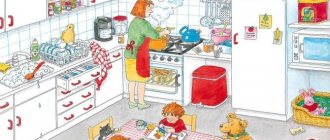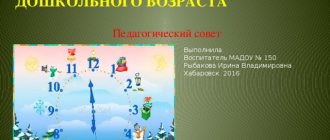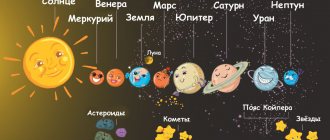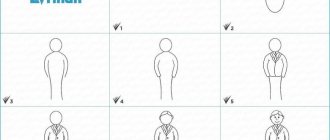MAGAZINE Preschooler.RF
Familiarization of senior preschool children with the state symbols of RussiaHomeland is the country where a person was born and lives, and of which he is a citizen. This is her land, nature, wealth. These are the people who inhabit the country and create its wealth, this is the way of life of society. At preschool age, children develop the simplest ideas about the environment, interest and positive attitudes towards the phenomena of social life that children can understand, civic position, and also certain personality traits are formed - activity, independence, initiative.
Before a child begins to perceive himself as a citizen of his country, it is necessary to form a moral foundation and help the child to successfully enter the modern world, to take a worthy place in the system of relations with others, which is impossible without nurturing love for loved ones, one’s fatherland, respect for the traditions and values of one’s people .
State symbols are part of the history and culture of the country. Familiarization with the most important state symbols - the coat of arms, flag, anthem - is traditionally included in the content of education and training programs.
I have created a series of conversations “I am a Russian” for children of senior preschool age to familiarize themselves with state symbols.
The purpose of my work:
- Formation of ideas about the state symbols of Russia (coat of arms, flag, anthem), about their main functions - to unite the inhabitants of the country, to serve as distinctive signs of the state.
- To cultivate a respectful attitude towards the state symbols of the Russian Federation, pride in belonging to the Russian state and its people.
Conversations for children of senior or preparatory groups are held in the afternoon as a joint activity between the teacher and the children, for one week, as they are part of the general plan for introducing preschoolers to their native country. The conversations are small in length, each subsequent conversation is a continuation of the previous one.
Preschool children have access to some basic ideas about heraldry and color symbolism.
To be able to read the coat of arms and flag, you need to know the meaning of the images, so the topic of the first conversation in the series is “Symbols” , from which children will learn about the historical meaning of some symbols based on folklore images (proverbs, legends and riddles). Color symbols: red, white, blue - the beauty of the world around us. Intricate patterns were embroidered on clothes using red and blue threads on white fabric. These colors have always been revered in Rus'.
The next stage of work is getting to know the Russian flag. At an older age, children begin to show interest in historical events, especially if they are presented in fairy-tale form and supported by illustrations. Their brightness and colorfulness help to form a positive attitude towards the coat of arms and flag, and the iconic-symbolic component involves the formation of elementary ideas about what is depicted, what the colors mean, and introduce them to the past and present of the country. (The first banners and flags with the faces of saints, the Russian ship "Eagle" , on which the white-blue-red flag was first raised).
In the next conversation, the children will learn about the anthem as a symbol that is always with you, because if you know the words and melody, you can always sing it.
The final conversation sums up the introduction and is called “I live in Russia ,” during which children consolidate their knowledge about the country and its symbols.
In his work, the teacher must take into account:
- One of the main features of the world around us is its change over time, so it is necessary to acquaint children with the fact that state symbols also change, like everything that surrounds us.
- The content of children's basic knowledge should have a historical basis, but take into account the child's age.
- The information received by children should be brief and not cover all the historical stages of the creation of these symbols.
- Russian symbols should not be considered in a political context.
- When preparing visual and didactic material, you should not use any aids that violate the integrity of the image of the state emblem and flag, or use coloring books, since by coloring a picture it is not always possible to accurately convey the colors of state symbols.
Thus, a series of conversations makes it possible to make the process of becoming familiar with the symbols of Russia systematic, developing, to form in a child a sense of belonging to a certain culture, history, and to plant a small seed of love for the Motherland in the souls of children.
I TOPIC OF CONVERSATION: Symbols.
Program content:
- Acquaintance with folk symbols;
- Development of cognitive interests;
- Cultivating interest in the history and culture of your country.
Preliminary work. Observing flags, road signs, and various symbols hanging on buildings while walking.
Material. Vocabulary, symbols: red cross, road signs, etc.
Move.
Offer children different symbols to look at.
- What is this? All this can be called a symbol.
— What is a symbol?
— Where can I find out the meaning of this symbol? (in dictionary).
Let's read what the dictionary says about this.
Symbols are different. Some came to us from ancient times, when people did not yet know how to read and did not know much. They thought that the earth was not round, but flat, like a pancake. The sun is a formidable man who lives in the sky. Riddle: . ”
—What else could you compare the sun to? (with a bird - an eagle, a firebird; with a beautiful maiden).
An eagle flies above the forest
Fire has wings
The whole world illuminates.
- Do you know riddles about the sun? Make a wish.
— A lot in our lives depends on the sun.
— If suddenly the sun disappears, what will happen?
—What color did people depict the sun? (red). They believed that red is the color of strength, courage, and beauty, since the word “red” means beautiful.
— Color used to be a symbol too. We talked about red.
— What can you say about the color blue?
- What can it mean? (sky, water (rivers, seas), fidelity, truth.) There are a lot of rivers and lakes in our country. That's why we loved this color.
-What does white mean? (cleanliness).
White, blue, red colors are the beauty of the surrounding world; these colors have always been revered in Rus'. Intricate patterns were embroidered with red and blue threads on white fabric. Multi-colored fabrics were used when sewing clothes.
(Consider folk costumes: (Russian, Khakass and others)).
Coloring Russian folk clothes, drawing the sun.
LITERATURE:
- Barannikova O.N. Lessons on citizenship and patriotism in kindergarten. – M.: ARKTI, 2007
- Magazine "Hoop" No. 3, 2003
- Kovaleva G.A. Raising a little citizen... - M.: ARKTI, 2005
- “My Country Russia” Vinogradova N.F., Sokolova N.A. M. Enlightenment. 2001
- "Heritage. Patriotic education in kindergartens" . Novitskaya M.Yu. M. Education, 2003
- Pchelov E.V. State symbols of Russia - coat of arms, flag, anthem. - M.: TID "Russian Word - RS" , 2004
- “Where does the Motherland begin?” Kondrykinskaya L.A. M. 2004
Domozhakova T.I.
Teacher of the MBDOU “Child Development Center - kindergarten “Ryabinushka”, Abakan, Republic of Khakassia.
| Next > |






